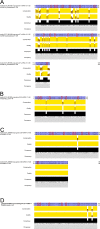Draft genome of the European medicinal leech Hirudo medicinalis (Annelida, Clitellata, Hirudiniformes) with emphasis on anticoagulants
- PMID: 32555498
- PMCID: PMC7303139
- DOI: 10.1038/s41598-020-66749-5
Draft genome of the European medicinal leech Hirudo medicinalis (Annelida, Clitellata, Hirudiniformes) with emphasis on anticoagulants
Abstract
The European medicinal leech has been used for medicinal purposes for millennia, and continues to be used today in modern hospital settings. Its utility is granted by the extremely potent anticoagulation factors that the leech secretes into the incision wound during feeding and, although a handful of studies have targeted certain anticoagulants, the full range of anticoagulation factors expressed by this species remains unknown. Here, we present the first draft genome of the European medicinal leech, Hirudo medicinalis, and estimate that we have sequenced between 79-94% of the full genome. Leveraging these data, we searched for anticoagulation factors across the genome of H. medicinalis. Following orthology determination through a series of BLAST searches, as well as phylogenetic analyses, we estimate that fully 15 different known anticoagulation factors are utilized by the species, and that 17 other proteins that have been linked to antihemostasis are also present in the genome. We underscore the utility of the draft genome for comparative studies of leeches and discuss our results in an evolutionary context.
Conflict of interest statement
The authors declare no competing interests.
Figures



Similar articles
-
Draft genome sequences of Hirudo medicinalis and salivary transcriptome of three closely related medicinal leeches.BMC Genomics. 2020 Apr 29;21(1):331. doi: 10.1186/s12864-020-6748-0. BMC Genomics. 2020. PMID: 32349672 Free PMC article.
-
More than just one: multiplicity of Hirudins and Hirudin-like Factors in the Medicinal Leech, Hirudo medicinalis.Mol Genet Genomics. 2016 Feb;291(1):227-40. doi: 10.1007/s00438-015-1100-0. Epub 2015 Aug 13. Mol Genet Genomics. 2016. PMID: 26267058
-
The hirudin-like factors HLF3 and HLF4-hidden hirudins of European medicinal leeches.Parasitol Res. 2020 Jun;119(6):1767-1775. doi: 10.1007/s00436-020-06697-1. Epub 2020 May 4. Parasitol Res. 2020. PMID: 32363441 Free PMC article.
-
Medicinal leech therapy (hirudotherapy): a brief overview.Complement Ther Clin Pract. 2010 Nov;16(4):213-5. doi: 10.1016/j.ctcp.2009.11.005. Epub 2010 Mar 6. Complement Ther Clin Pract. 2010. PMID: 20920805 Review.
-
Proteinase inhibitors from the European medicinal leech Hirudo medicinalis: structural, functional and biomedical aspects.Mol Aspects Med. 1995;16(3):215-313. doi: 10.1016/0098-2997(95)00002-x. Mol Aspects Med. 1995. PMID: 8569452 Review. No abstract available.
Cited by
-
Diversity of hirudin and hirudin-like factor genes in the North-African medicinal leech, Hirudo troctina.Parasitol Res. 2024 Nov 14;123(11):382. doi: 10.1007/s00436-024-08411-x. Parasitol Res. 2024. PMID: 39540973 Free PMC article.
-
Comparative genomics of three non-hematophagous leeches (Whitmania spp.) with emphasis on antithrombotic biomolecules.Front Genet. 2025 Feb 26;16:1548006. doi: 10.3389/fgene.2025.1548006. eCollection 2025. Front Genet. 2025. PMID: 40078478 Free PMC article.
-
A Chromosome-Level Genome Assembly of the Non-Hematophagous Leech Whitmania pigra (Whitman 1884): Identification and Expression Analysis of Antithrombotic Genes.Genes (Basel). 2024 Jan 26;15(2):164. doi: 10.3390/genes15020164. Genes (Basel). 2024. PMID: 38397154 Free PMC article.
-
Macrobdella decora: Old World Leech Gut Microbial Community Structure Conserved in a New World Leech.Appl Environ Microbiol. 2021 Apr 27;87(10):e02082-20. doi: 10.1128/AEM.02082-20. Print 2021 Apr 27. Appl Environ Microbiol. 2021. PMID: 33674439 Free PMC article.
-
Hookworm genes encoding intestinal excreted-secreted proteins are transcriptionally upregulated in response to the host's immune system.bioRxiv [Preprint]. 2025 Feb 3:2025.02.01.636063. doi: 10.1101/2025.02.01.636063. bioRxiv. 2025. PMID: 39975173 Free PMC article. Preprint.
References
-
- Salzet M. Anticoagulants and inhibitors of platelet aggregation derived from leeches. FEBS Lett. 2001;492(3):187–192. - PubMed
-
- Kvist S, Brugler MR, Goh TG, Giribet G, Siddall ME. Pyrosequencing the salivary transcriptome of Haemadipsa interrupta (Annelida: Clitellata: Haemadipsidae): anticoagulant diversity and insight into the evolution of anticoagulation capabilities in leeches. Inv. Biol. 2014;133(1):74–98.
-
- Siddall ME, Min GS, Fontanella FM, Phillips AJ, Watson SC. Bacterial symbiont and salivary peptide evolution in the context of leech phylogeny. Parasitol. 2011;138(13):1815–1827. - PubMed
Publication types
MeSH terms
Substances
LinkOut - more resources
Full Text Sources
Medical
Research Materials

